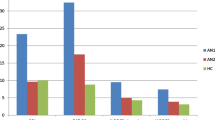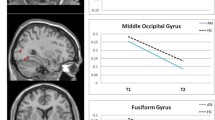Abstract
Purpose
Research suggests that there are cognitive inefficiencies underlying Anorexia Nervosa (AN), with CRT showing promise in improving these inefficiencies in adults. This area has yet to be explored in a younger population. The aim of this study was to evaluate the use of CRT for young people.
Methods
A within-subjects design was used to compare the performance of children and adolescents with AN on several neuropsychological measures administered before and after a course of CRT.
Results
Ninety-two female participants diagnosed with AN aged between 11 and 17 (M = 14.8, SD = 1.6), all receiving treatment at a specialist inpatient unit. The assessment consisted of the Rey–Osterrieth Complex Figure test (ROCFT), the Behaviour Rating Inventory of Executive Function–Self-Report (BRIEF-SR), and the D-KEFS Colour-Word Interference Test (CWT). Repeated-measures t tests were used to analyse the ROCFT and BRIEF-SR data. There was a significant improvement in Central Coherence Index (p < .001), Immediate Recall (p < .001), Shift (p < .001) Cognitive Shift (p = 002), Behavioural shift (p < .001), Emotional Control (p < .001), Working Memory (p = .001), Plan/Organize (p < .001), Monitor (p = .001) BRI (p < .001), MI (p = .001), and GEC (p < .001). On the D-KEFS CWT, a repeated-measure Wilcoxon signed-rank test revealed a significant improvement in Error Rate (p = .019) and a repeated-measures t test revealed a significant improvement in time taken (p < .001).
Conclusions
Results suggest that CRT for children and adolescents with AN could strengthen specific cognitive domains.
Similar content being viewed by others
References
American Psychiatric Association (2013) Diagnostic and statistical manual of mental disorders, 5th edn. American Psychiatric Publishing, Washington
Hoek HW (2006) Incidence, prevalence and mortality of anorexia nervosa and other eating disorders. Curr Opin Psychiatry 19:389–394
Lang K, Lopez C, Stahl D, Tchanturia K, Treasure J (2014) Central coherence in eating disorders: an updated systematic review and meta-analysis. World J Biol Psychiatry 15:586–598
Tchanturia K, Davies H, Roberts M, Harison M, Nakazato M, Schmidt U, Treasure J, Morris R (2012) Poor cognitive flexibility in eating disorders: examining the evidence using the wisconsin card sorting task. PLoS One 7:e28331. doi:10.1371/journal.pone.0028331
Tchanturia K, Harrison A, Davies H, Roberts M, Oldershaw A, Nakazato M, Stahl D, Morris R, Schmidt U, Treasure J (2011) Cognitive flexibility and clinical severity in eating disorders. PLoS One 6:e20462. doi:10.1371/journal.pone.0020462
Wu M, Brockmeyer T, Hartmann M, Skunde M, Herzog W, Friederich HC (2014) Set-shifting ability across the spectrum of eating disorders and in overweight and obesity: a systematic review and meta-analysis. Psychol Med 22:3365–3385. doi:10.1017/S0033291715000294
Stedal K, Rose M, Frampton I, Landrø NI, Lask B (2012) The neuropsychological profile of children, adolescents, and young adults with anorexia nervosa. Arch Clin Neuropsychol 27:329–337. doi:10.1093/arclin/acs032
Tenconi E, Santonastaso P, Degortes D, Bosello R, Titton F, Mapelli D, Favaro A (2010) Set-shifting abilities, central coherence, and handedness in anorexia nervosa patients, their unaffected siblings and healthy controls: exploring putative endophenotypes. World J Biol Psychiatry 11:813–823
Lask B, Frampton I (2011) Eating disorders and the brain. John Wiley & Son, Chichester, West Sussex
Lang K, Tchanturia K (2014) A systematic review of central coherence in young people with Anorexia Nervosa. J Child Adolesc Behav 2:140. doi:10.4172/jcalb.1000140
Lang K, Stahl D, Espie J, Treasure J, Tchanturia K (2014) Set shifting in children and adolescents with anorexia nervosa: an exploratory systematic review and meta-analysis. Int J Eat Disord 47:394–399. doi:10.1002/eat.22235
Lang K, Lloyd S, Khondoker M, Simic M, Treasure J, Tchanturia K (2015) Do children and adolescents with anorexia nervosa display an inefficient cognitive processing style? PLoS One 10:e0131724. doi:10.1371/journal.pone.0131724
Rose M, Frampton I, Lask B (2014) Central coherence, organizational strategy, and visuospatial memory in children and adolescents with anorexia nervosa. Appl Neuropsychol Child 3:284–296. doi:10.1080/21622965.2013.775064
Kjaersdam Telléus G, Jepsen JR, Bentz M, Christiansen E, Jensen SO, Fagerlund B, Thomsen PH (2015) Cognitive profile of children and adolescents with anorexia nervosa. Eur Eat Disord Rev 23:34–42. doi:10.1002/erv.2337
Wykes T, van der Gaag M (2001) Is it time to develop a new cognitive therapy for psychosis—Cognitive remediation therapy (CRT)? Clin Psychol Rev 21:1227–1256
McGurk SR, Twamley EW, Sitzer DL, McHugo GJ (2007) A meta-analysis of cognitive remediation in schizophrenia. Am J Psychiatry 164:1791–1802. doi:10.1176/appi.ajp.2007.07060906
Tchanturia K (2014) Cognitive Remediation Therapy (CRT) for eating and weight disorders. Routledge, Hove, East Sussex
Davies H, Tchanturia K (2005) Cognitive remediation therapy as an intervention for acute anorexia nervosa: a case report. Eur Eat Disord Rev 13:311–316. doi:10.1002/erv.655
Tchanturia K, Whitney J, Treasure J (2006) Can cognitive exercises help treat anorexia nervosa? A case report. Eat Weight Disord 11:e112–e117
Tchanturia K, Davies H, Lopez C, Schmidt U, Treasure J, Wykes T (2008) Neuropsychological task performance before and after cognitive remediation in anorexia nervosa: a pilot case-series. Psychol Med 38:1371–1373. doi:10.1017/S0033291708003796
Tchanturia K, Lounes N, Holttum S (2014) Cognitive remediation in anorexia nervosa and related conditions: a systematic review. Eur Eat Disord Rev 22:454–462. doi:10.1002/erv.2326
Tchanturia K, Lloyd S, Lang K (2013) Cognitive remediation therapy for anorexia nervosa: current evidence and future research directions. Int J Eat Disord 46:492–496. doi:10.1002/eat.22106
Wood L, Al-Khairulla H, Lask B (2011) Group cognitive remediation therapy for adolescents with anorexia nervosa. Clin Child Psychol Psychiatry 16:225–231. doi:10.1177/1359104511404750
Pretorius N, Dimmer M, Power E, Eisler I, Simic M, Tchanturia K (2012) Evaluation of a cognitive remediation therapy group for adolescents with anorexia nervosa: pilot study. Eur Eat Disord Rev 20:321–325. doi:10.1002/erv.2176
Dahlgren CL, Lask B, Landrø NI, Rø Ø (2014) Patient and parental self-reports of executive functioning in a sample of young female adolescents with anorexia nervosa before and after cognitive remediation therapy. Eur Eat Disord Rev 22:45–52. doi:10.1002/erv.2265
Gioia GA, Isquith PK, Guy SC, Kenworthy L (2000) Behavior rating inventory of executive function: professional manual. Psychological Assessment Resources Inc, USA
van Noort BM, Kraus MK, Pfeiffer E, Lehmkuhl U, Kappel V (2016) Neuropsychological and behavioural short-term effects of cognitive remediation therapy in adolescents with anorexia nervosa: a pilot study. Eur Eat Disord Rev. 24:69–74. doi:10.1002/erv.2383
Osterrieth PA (1944) Le teste du copie d’une figure complexe. Arch de Psychol 38:206–356
Delis DC, Kaplan E, Kramer JH (2001) Delis-Kaplan executive function system (D-KEFS). The Psychological Corporation, San Antonio
Rose M, Davis J, Frampton I, Lask B (2011) The Ravello profile: development of a global standard neuropsychological assessment for young people with anorexia nervosa. Clin Child Psychol Psychiatry 16:195–202. doi:10.1177/1359104511401191
Tchanturia K, Davies H, Reeder C, Wykes T (2010) Cognitive remediation therapy for anorexia nervosa. http://media.wix.com/ugd/2e1018_f71866481f9f44e5a342fb068b891a8c.pdf. Accessed 23 Sept 2016
Lindvall C, Owen I, Lask B (2011) Cognitive remediation therapy for children and adolescents with anorexia nervosa—the CRT resource pack. Olso University Hospital, Ulleål, HF. http://www.oslouniversitetssykehus.no/SiteCollectionDocuments/Fagfolk/Forskning%20og%20utvikling/RASP/1.-7.%20The%20CRT%20Recource%20Pack.pdf. Accessed 23 Sept 2016
Giombini L, Turton R, Turco M, Nesbitt S, Lask B (2016) The use of cognitive remediation therapy on a child adolescent eating disorder unit: patients and therapists perspectives. Clin Child Psychol Psychiatry. doi:10.1177/1359104516657859
Booth R (2006) Local-global processing and cognitive style in autism spectrum disorders and typical development. Institute of Psychiatry, King’s College London, London. https://kclpure.kcl.ac.uk/portal/files/2935437/433168.pdf. Accessed 23 Sept 2016
Fairburn CG, Beglin SJ (1994) Assessment of eating disorders: interview or self-report questionnaire. Int J Eat Disord 16:363–370
Fairburn CG (2008) Cognitive behavior therapy and eating disorders. Guilford Press, New York
Spielberger CD, Gorsuch RL, Lushene R, Vagg PR, Jacobs GA (1983) Manual for the state-trait anxiety scale. Consulting Psychologists Press, Palo Alto
Junior MARSIPAN Guidelines (2012) Management of really sick inpatients with anorexia nervosa. Royal College of Psychiatrists, London. http://www.rcpsych.ac.uk/files/pdfversion/CR168nov14.pdf. Accessed 23 Sept 2016
Treasure J, Schmidt U (2013) The cognitive-interpersonal maintenance model of anorexia nervosa revisited: a summary of the evidence for cognitive, socio-emotional and interpersonal predisposing and perpetuating factors. J Eat Disord 1:13. doi:10.1186/2050-2974-1-13
Lozano-Serra E, Andrés-Perpiña S, Lázaro-García L, Castro-Fornieles J (2014) Adolescent anorexia nervosa: cognitive performance after weight recovery. J Psychosom Res 76(1):6–11. doi:10.1016/j.jpsychores.2013.10.009 PMID 24360134
Acknowledgments
The authors would like to thank Prof. Bryan Lask for introducing CRT in our service and the support and guidance he provided.
Author information
Authors and Affiliations
Corresponding author
Ethics declarations
Disclosure of potential conflicts of interest
All authors declare that they have no conflict of interest.
Ethical approval
For this study, formal ethical approval is not required, as the therapy and assessments were a part of the standard treatment programme. The assessments were conducted to inform the content of the Cognitive Remediation Therapy sessions and to provide feedback to the patients.
Informed consent
Informed consent was obtained from all parents or guardians and individual participants included in the study at the admission.
Additional information
L. Giombini and J. Moynihan indicate co-first authorship.
Rights and permissions
About this article
Cite this article
Giombini, L., Moynihan, J., Turco, M. et al. Evaluation of individual cognitive remediation therapy (CRT) for the treatment of young people with anorexia nervosa. Eat Weight Disord 22, 667–673 (2017). https://doi.org/10.1007/s40519-016-0322-4
Received:
Accepted:
Published:
Issue Date:
DOI: https://doi.org/10.1007/s40519-016-0322-4




